U.S. Department of Transportation
Federal Highway Administration
1200 New Jersey Avenue, SE
Washington, DC 20590
202-366-4000
Federal Highway Administration Research and Technology
Coordinating, Developing, and Delivering Highway Transportation Innovations
|
Research & Technology Transporter This newsletter is an archived publication and may contain dated technical, contact, and link information. |
|
| Publication Number: N/A Date: May 2006 |
Publication Date: May 2006
|
According to the National Highway Traffic Safety Administration, motor vehicle crashes are the leading cause of death for teenagers, killing more than 6,000 every year. The California Office of Traffic Safety has found that a 16-year-old is 20 times more likely to be killed in a crash than an adult, due largely to driving inexperience. These additional risks also are present in highway work zones, where a teenage driver is killed every 3 days, and seven teenagers are injured each day. Over the next several years, highway construction is expected to increase by 33 to 65 percent, and the number of roadway work sites will increase proportionally.
To improve the safety of new teen drivers in work zones, the Federal Highway Administration (FHWA) and American Road & Transportation Builders Association (ARTBA) have developed a multifaceted campaign called "Turning Point: Roadway Work Zone Safety for New Drivers." The campaign is based on the theme that new drivers are at turning points in their lives. It is intended to help them understand the hazards they may encounter while driving through work zones and learn how they can travel through work zones more safely.
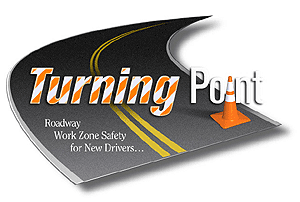 |
| The Turning Point logo is shown. (Photo credit: ARTBA) |
FHWA and ARTBA designed Turning Point to be used primarily in the driver education process, but it also can be a resource for others, including parents of new drivers. The campaign has five messages to help new drivers negotiate highway situations:
The campaign delivers these messages using a variety of products, including the following:
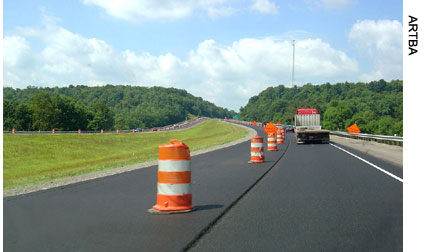 |
| The Turning Point program focuses on teaching new drivers how to handle the challenges of driving in work zones, such as the one shown here. |
Since the program materials were first released, demand for them has grown, and hard copies of the materials are available only in limited supply. Individuals are encouraged to visit the Web site to download materials and find out more about the campaign. In addition, campaign materials have been packaged into a toolkit that FHWA and ARTBA have already distributed to many driving instructors, State agencies, and other interested parties. To facilitate reproduction, the CD-ROM contains electronic versions of all documents and collateral materials included in the toolkits.
For more information, contact:
Ken Opiela 202-493-3371 kenneth.opiela@fhwa.dot.gov
Tracy Scriba 202-366-0855 tracy.scriba@fhwa.dot.gov
Jim Childers 202-289-4434 jchilders@artba.org
In recent years, the Federal Government has changed some of the ways that agencies address the potential impacts of transportation projects on properties of historic and cultural significance. The changes have included a new emphasis on environmental streamlining and stewardship and revisions to the regulations implementing Section 106 of the National Historic Preservation Act. Section 106 requires that Federal agencies take into account the effects of their activities on historic properties. In addition, current regulations strongly encourage close coordination between activities relating to Section 106 and the National Environmental Policy Act (NEPA), and require greater coordination with stakeholders during the transportation planning process.
To help transportation professionals learn about these changes, the Federal Highway Administration's (FHWA) National Highway Institute (NHI) is offering the course Beyond Compliance: Historic Preservation in Transportation Project Development (FHWA-NHI-142049). NHI designed the course to help professionals meet Section 106 requirements and take advantage of the greater flexibility and streamlining opportunities offered by the recent revisions to the requirements.
The course emphasizes the practical application of Section 106 to real-world situations in the context of transportation planning, NEPA, and Section 4(f) of the Department of Transportation Act, which regulates use of all historic properties, as well as publicly owned parks, recreation areas, and wildlife or waterfowl refuges. After completing the course, participants will be able to:
The course targets professionals involved in or affected by the Federal-Aid Highway Program, including staff from FHWA's headquarters and field offices, State departments of transportation (DOTs), metropolitan planning organizations, city and county governments, tribal governments, State and tribal historical preservation offices, and Federal and State resource agencies that handle transportation issues. Although there are no formal prerequisites for the course, participants will benefit by having some familiarity with Section 106, NEPA, and the project planning process.
The course was created by a team of specialists under the guidance of an interdisciplinary panel made up of representatives from FHWA, State DOTs, the Advisory Council on Historic Preservation, and Native American tribes. The addition of this course to the NHI catalog reflects FHWA's emphasis on stewardship and streamlining, and the integration of NEPA into the transportation project planning process. For more information about the course, visit www.nhi.fhwa.dot.gov or contact:
MaryAnn Naber 202-366-2060 maryann.naber@fhwa.dot.gov
Because the highway network is critical to the Nation's economy, maintenance of the roadways is essential to the continued movement of goods and services. Highway managers, however, have few financial resources to pay for upkeep of the Nation's aging roadways. These professionals can benefit from an enhanced maintenance management system (MMS) to help them oversee the roadways.
The challenges of meeting the needs of the traveling public in the 21st century with limited funding led the Federal Highway Administration's (FHWA) National Highway Institute (NHI) to develop the course Principles and Practices for Enhanced Maintenance Management Systems (FHWA-NHI-131107). Members of the Management Systems Focus Group of the American Association of State Highway and Transportation Officials' (AASHTO) Subcommittee on Maintenance helped develop the course as an introduction to the use of an enhanced MMS.
Upon completing the course, participants will be able to:
The course materials rely on AASHTO's recently developed Guidelines for Maintenance Management Systems. The new course targets State and local maintenance engineers, maintenance supervisors, asset managers, and their private sector counterparts. In particular, individuals responsible for directing and managing maintenance operations and budgets, selecting maintenance projects, or monitoring system conditions will benefit from the course. There are no prerequisites.
For information about scheduling or participating in this course, contact the NHI Training Team at 703-235-0534 or nhitraining@fhwa.dot.gov. For answers to technical questions about the course, contact:
Celso Gatchalian 202-366-1342 celso.gatchalian@fhwa.dot.gov
Albert Einstein once said, "To raise new questions, new possibilities, to regard old problems from a new angle, requires creative imagination and marks real advance in science." No doubt Einstein would have applauded the middle school students who combined creative imagination with scientific knowledge to solve engineering problems in the 2006 National Engineers Week Future City CompetitionTM. The Future City program, now in its 14th year, challenges students to create cities of the future, first on computers and then as tabletop models.
Working in teams with a teacher and a volunteer engineer from the local community, students in this year's competition created their cities using simulation software and developed concepts for transportation, energy, housing, education, and commercial facilities. Each team then built a scale model of their city from recycled materials, including recycled cardboard or wood. They also wrote abstracts about their projects and essays on this year's theme: creating an engineering feasibility plan to redevelop an abandoned strip mall.
Teams winning local and regional competitions received expense-paid trips to the national finals in February 2005, in Washington, DC. At the finals, the teams presented and defended their model cities before the judges, who are professional engineers. The judges gave awards to the top 5 teams and 29 special awards in specific areas. Each year, the Federal Highway Administration (FHWA) sponsors one of the specific awards to encourage students to consider careers in engineering and transportation, and to promote appreciation of the role transportation plays in enhancing the quality of life.
This year, the judges selected the team from Valley Middle School in Oakland, NJ, as the winner of the FHWA transportation award. The team members proposed that their city, Tchiaq Shishmaref, be located on a small island in the Bering Strait region of Alaska. Tchiaq Shishmaref features several creative transportation systems, including rapid transit between the mainland and the island, a subsurface transport system in the city itself, and a Space Elevation Transporter that can move passengers throughout the city at speeds up to 4,023 kilometers (2,500 miles) per hour. The city also has traditional highways and sidewalks, but they are constructed of a foamlike polyurethane substance heated by molecular friction to prevent icing. Team members Michael Ahrendt, Alicia Henneberry, and Bryan Jarmusch explained the concepts they incorporated in their model city with the aplomb and confidence of university researchers, according to the FHWA judges participating in the competition.
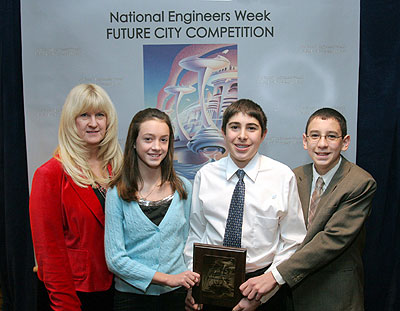 |
| A team from Valley Middle School in Oakland, NJ, won FHWA's transportation award at this year's Future City competition. Shown accepting the award (left to right) are the students' teacher Judith Vihonski, and students Alicia Henneberry, Michael Ahrendt, and Bryan Jarmusch. |
Other imaginative solutions presented at the competition included a concept by the Miami, FL, team, which proposed that its city of the future be submersible so that residents would not have to evacuate during a hurricane. The Chicago, IL, team proposed a massive city in space with interplanetary superhighways that, according to the team's essay, are "paths through our solar system where gravitational forces and rotational forces are balanced. This provides a 'free ride' through space with very little fuel required."
National Engineers Week is an annual event designed to bring public attention to the work and contributions of the Nation's engineers. Founded by the National Society of Professional Engineers®, the week is sponsored by hundreds of engineering societies, government agencies, corporations, and universities to encourage interest in engineering careers. For more information, visit www.eweek.org. For more information on the Future City program, visit www.futurecity.org.
Martha Soneira 202-493-3468 martha.soneira@fhwa.dot.gov
On January 25, 2006, during a meeting of the Transportation Research Board (TRB) Executive Committee, Executive Director John Horsley of the American Association of State Highway and Transportation Officials (AASHTO), President Ralph J. Cicerone of the National Academy of Sciences (NAS), and Acting Administrator J. Richard Capka of the Federal Highway Administration (FHWA) signed a memorandum of understanding (MOU) to establish the second Strategic Highway Research Program (SHRP II), affirming the partnership to conduct this research program.
The U.S. Congress authorized SHRP II under Section 5210 of the Safe, Accountable, Flexible, Efficient Transportation Equity Act: A Legacy for Users (SAFETEA-LU) in August 2005. SAFETEA-LU instructs the U.S. Secretary of Transportation to establish SHRP II in consultation with AASHTO and acting through NAS's National Research Council. TRB will conduct and administer the program.
SHRP II is a targeted, short-term, results-oriented program of strategic highway research designed to advance highway performance and safety for U.S. highway users. SHRP II will focus on applied research in four areas to meet the following goals:
These areas of research were identified by a TRB-established committee chosen from the highway community, including leaders from the public and private sectors, academia, and user and stakeholder associations. The committee conducted extensive outreach among stakeholders representing user groups, the private sector, various interest groups, and universities as well as Federal and local agencies and all State departments of transportation (DOTs). The results of the outreach and the committee's work are published in TRB Special Report 260, Strategic Highway Research-Saving Lives, Reducing Congestion, Improving Quality of Life.
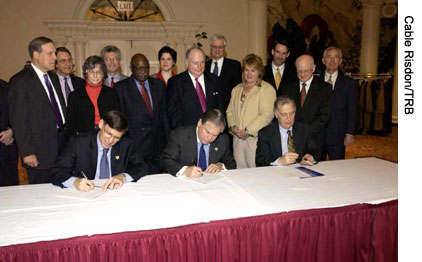 |
| FHWA Acting Administrator J. Richard Capka, AASHTO Executive Director John Horsley, and NAS President Ralph J. Cicerone (seated left to right) sign the SHRP II MOU on January 25, 2006, with attendees of the TRB Executive Committee meeting looking on. |
Under TRB's administration, SHRP II will operate through an Oversight Committee, Technical Coordinating Committees (TCC), and Expert Task Groups, drawing on volunteer experts from the broad spectrum of transportation organizations across the country.
The FHWA Administrator is an ex-officio member of the SHRP II Oversight Committee, which held its first meeting in January 2006. The Oversight Committee meets twice a year, approves an annual work plan and budget, and develops an annual progress report. TCCs will be established to oversee the work programs for each of the four strategic focus areas. The groups are expected to meet by early summer 2006 to vet the first year's projects to be proposed to the Oversight Committee. It is anticipated that Expert Task Groups also will be formed to guide work in specific topic areas under the four goals.
FHWA has identified liaisons from its headquarters office and the Turner-Fairbank Highway Research Center for each of the four focus areas:
The first requests for proposals for research activities under SHRP II will be issued during summer 2006, followed by the awarding of initial contracts. All work under the program will be completed by 2011.
FHWA has been involved in all stages of the development of SHRP II and will continue to be involved in the program as the research is conducted and as implementation of the products occurs. Each State also has been invited to appoint a SHRP Coordinator to act as the primary point of contact between the program and State DOT. The expectation is that the SHRP Coordinator will be the transportation research director in many States.
Recruitment for some paid staff at SHRP II has begun and will continue for some months to come. To supplement this staff and provide a developmental opportunity for many more people in the transportation community, SHRP II will have temporary positions for loan staff after the program is initiated. For more information about SHRP II, visit www.trb.org/shrpii or contact:
William Zaccagnino 202-493-3183 william.zaccagnino@fhwa.dot.gov
Scientific studies have indicated that mobile source air toxics (MSATs) may pose significant health risks. Emitted primarily by motor vehicles through the incomplete combustion of fuel, MSATs are believed to contribute to lung cancer and other adverse health effects. The U.S. Environmental Protection Agency (EPA) estimates that MSATs account for as much as half of all cancers attributed to outdoor sources of air toxics.
In recent years, the Federal Highway Administration's (FHWA) division offices and State departments of transportation (DOTs) have received an increasing number of requests to analyze how proposed projects will contribute to MSAT emissions. Staff at many of these offices has little experience with this type of analysis. To provide transportation professionals with the necessary skills and experience to perform these analyses, the FHWA Resource Center's Air Quality Technical Service Team has developed the FHWA Workshop on Project-Level Mobile Source Air Toxics. The 2-day training session targets staff from FHWA, State DOTs, and air quality agencies, as well as consultants.
The Resource Center team divided the workshop into two parts. The first part provides participants with a background on MSATs and includes a presentation on technical tools, such as EPA's MOBILE6.2 emissions model. The second part gives participants an opportunity to practice using analytic methods.
During the first day of the workshop, the instructors define MSATs and describe how they became an issue for highway projects. The instructors focus on real-world applications by discussing guidance issued by FHWA in February 2006 on air toxics analysis for documents prepared under the National Environmental Policy Act. Participants also learn about examples of MSAT analyses from actual projects, the uncertainties associated with existing analytical tools, and the important issues to consider when interpreting and reporting results of an MSAT analysis.
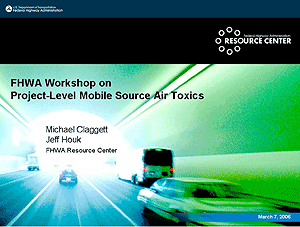 |
| The opening slide presented during FHWA's MSAT workshop is shown. |
During the afternoon of the first day, the instructors present FHWA's recommendations for deciding which roadway segments to analyze to best capture the MSAT impacts of a project. The instructors also present a comprehensive summary of the inputs and data needed to use the MOBILE6.2 emissions model.
The second day is a hands-on modeling session that enables participants to go through the steps involved in analyzing a typical highway project while having the benefit of FHWA's advice and assistance. Participants select a transportation network for analysis, calculate vehicle speeds, run the MOBILE6.2 model to generate emissions rates, and then calculate total emissions for the project alternatives.
To date, staff members from the FHWA Resource Center have presented the workshop in Arizona, Colorado, Minnesota, Texas, and Washington. Additional sessions are planned for California, New York, and Pennsylvania. Other workshops are planned for later in the year, though those locations and dates also are not yet scheduled.
In addition to the 2-day workshop, the Resource Center team is developing a half-day session that could be presented via Web conference; a CD-ROM with background and technical information, including the workshop materials, EPA and FHWA guidance documents and reports, and examples of MSAT analyses; and a document to address frequently asked questions. FHWA Resource Center staff members also are available to provide technical assistance. To schedule a workshop or for more information, contact:
Jeff Houk 720-963-3203 jeff.houk@fhwa.dot.gov
Statistics from the Federal Highway Administration (FHWA) indicate that work zones account for nearly 24 percent of nonrecurring congestion. In addition, work zone crash fatalities in 2004 reached 1,065, and more than 41,000 people were injured in work zone crashes in 2003. To improve safety and mitigate congestion caused by work zones, many transportation agencies are turning to intelligent transportation systems (ITS). These technologies help agencies monitor and manage traffic flow through work zones and increase safety for both road workers and users. By enabling better traffic flow, ITS technologies also can help reduce construction time and overall costs.
 |
To increase the use of innovative technologies and practices, FHWA organized a series of workshops, "Making Work Zones Work Better." The use of ITS for work zone management has been one of the key topics presented and discussed during the workshops. Since 2002, FHWA has held more than 25 of these workshops, which typically include presentations by staff from FHWA, State departments of transportation (DOTs), and technology providers. The presentations on work zone ITS at these workshops have often been given by speakers from State DOTs, all of whom have used work zone ITS.
FHWA also has partnered with the American Association of State Highway and Transportation Officials (AASHTO) to encourage the implementation of work zone ITS through an AASHTO Technology Implementation Group project. This effort led to a workshop in September 2005, in St. Louis, MO, that was attended by representatives from nearly half of the State DOTs in the Nation. Tracy Scriba, a member of the Work Zone Mobility & Safety Team in FHWA's Office of Operations, began the workshop by providing an overview of the use of ITS in work zones. She noted that ITS technologies often are used for effective work zone management and operations, are employed in and around work zones, can have a safety or mobility focus but often support both, are portable and temporary in most cases, and may be leased or purchased. ITS technologies typically include input devices, such as cameras; automated analysis of data; and output devices, such as dynamic messages signs, Web sites, or highway advisory radio.
Also during the St. Louis workshop, Mike Fontaine of the Virginia Transportation Research Council discussed the deployment of dynamic messaging signs that carry speed advisories, travel times, delay announcements, and alternate route alerts. According to Fontaine's review of available studies on work zone ITS, 46 percent to 73 percent of polled motorists said they in fact slowed down when they saw speed advisories. When they saw other types of alerts and advisories, 50 percent to 85 percent of motorists said they changed their route at least sometimes. According to Fontaine, motorists indicated that dynamic message signs that included warnings about traffic congestion were helpful especially when the signs included specific exits and roads. Successful route diversions also had payoffs for queue management, such as a 50-percent to 60-percent reduction in the length of vehicle lines.
Also during the workshop, Brian Manthey, a communications officer with the Wisconsin Department of Transportation, spoke on building public trust through reliable communications. Rounding out the presentations, representatives from the North Carolina and Minnesota DOTs spoke about work zone ITS contracts; Tracy Scriba spoke on planning and implementing a work zone ITS project; a representative of the Maryland State Highway Administration spoke about that agency's experience with work zone evaluations; and representatives from the Missouri, Illinois, and Pennsylvania DOTs provided case studies.
For more information, visit http://tig.transportation.org/?siteid=57&pageid=1594.
Tracy Scriba 202-366-0855 tracy.scriba@fhwa.dot.gov